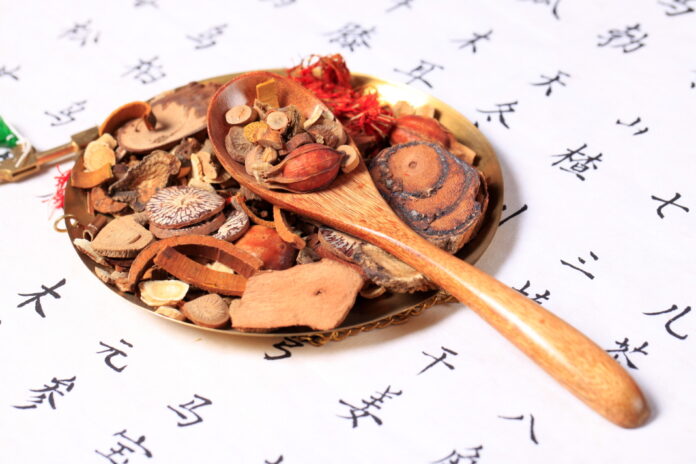Finding A Guiding Herb Makes Easier to Find the Most Efficient Formula ③ Fu Zi
Fu Zi, Gui Zhi, and Wu Zhu Yu Share Similar Function, but its Indications are Different
By Hyunchang Cho, L.Ac., Ph.D
- Pharmacological Hypothesis of Fu Zi
|
Poor blood circulation due to decreased metabolism and reduced cardiac output → decreased thermogenesis, → decreased surface, and core body temperatures |
||||||
|
↓ |
↓ |
↓ |
↓ |
|||
|
Cold intolerance, coldness of the limbs and other body parts |
Cold pain due to poor blood circulation of the joints ☞Slow pathway of chronic pain |
Decreased neural conduction |
||||
|
↓ |
↓ |
|||||
|
Dullness and paresthesia due to decreased neural conduction of the somatosensory system |
Declined physical ability of the voluntary muscles due to decreased neural conduction of the motor nerves |
|||||
|
↓ |
↓ |
↓ |
↓ |
|||
|
cold intolerance and cold extremities |
Body aches |
Dullness and paresthesia |
Heaviness |
|||
The underlying mechanism of the Fu Zi Pattern seems to be decreased metabolism, and reduced cardiac output → poor blood circulation → decreased thermogenesis → decreased surface and core body temperatures.
1) As a result, cold intolerance and coldness of the extremities occur.
2) Decreased body temperature will lead to the poor blood circulation of the joints, which will induce cold body pains. Fu Zi’s pain seems to follow the chronic (slow) pain pathway model.
- Why does the pain occur when the body temperature drops?
- If the body temperature drops, the circulation of the blood is impaired, which causes pain.
- What is the mechanism of Fu Zi’s body pain that accompanies cold intolerance?
- Fu Zi’s body pain seems to follow a chronic pain pathway.
Mechanism of Chronic Pain (Slow Pain)
Chronic Pain (slow Pain) Mechanism
Decreased body temperature → Ischemia of tissues → Production of pain-inducing substances → Stimulation of pain receptors → Chronic pain (slow pain)
- Decreasing body temperature causes tissue ischemia.
- Chemicals such as bradykinin and proteolytic enzymes produced by large amounts of lactic acid or damage to cells that have become ischemic in tissue stimulate the pain receptors.
- With slow pain, the exact site of the painful area is hard to pinpoint.
3) Decreased body temperature seen in Fu Zi pattern reduces nerve conductivity carried out by electrical signals in neurons, resulting in numbness, paresthesia, decreased muscle movement, and muscle weakness. In some cases, cold intolerance and coldness of the limbs in the Fu Zi pattern may be accompanied by numbness of the sensory nerves and abnormal sensations resulting from poor conductivity of the sensory nervous system and impairment in voluntary muscle movement due to poor conductivity of the motor nervous system.
- How does the body temperature decline in Fu Zi Pattern lead to numbness and paresthesia?
- Decrease in body temperature → Decrease in neuronal membrane thickness (most notably at 23°C to 30°C) → Increase in membrane potential difference → Decrease in frequency of action potential occurrence (dv/dx) → Decrease in neuroconductivity
– As the body temperature decreases, the thickness of the neuronal cell membrane decreases, and the membrane potential difference increases, which reduces the frequency of action potential occurrence.
– This is most noticeable at body temperature between 23°C and 30°C. If the temperature is below 8℃, the Na+ channel becomes “sleepy.”
- How does the body temperature decline in Fu Zi Pattern lead to the heaviness of the limbs?
- Decrease in body temperature → Decrease in water solubility in neurotransmitter receptors → Decrease in muscle activity, alertness, and power
It seems the decline of body temperature in the Fu Zi pattern results from decreased thermogenesis due to diminished systemic metabolism and cardiovascular circulation failure. The temperature of both the body surface and the core is reduced, resulting in an aversion to cold (cold intolerance) and coldness of the limbs. Cold intolerance and coldness of the limbs in the Fu Zi pattern are usually worse than in Gui Zhi and Wu Zhu Yu patterns. Fu Zi patients would say things like, ‘I am very sensitive to cold. My body is cold as ice. My hands, feet, or other parts of the body are very, very cold.’
○ Comparing Gui Zhi, Wu Zhu Yu, and Fu Zi
|
Gui Zhi |
Wu Zhu Yu |
Fu Zi |
|
aversion to cold and cold limbs combined with Upper Heat |
aversion to cold and cold limbs combined with cold pain in the lower abdomen (Cold Hernia) |
aversion to cold and cold limbs which are rarely combined with numbness or heaviness in certain parts of the body |
|
Cold Scale: 5 (more or less) out of 10 |
Cold Scale: 5 (more or less) From 2,3,4 to 6,7,8,9 out of 10 |
Cold Scale: 7,8,9 out of 10 |
|
aversion to cold and cold limbs are sometimes accompanied by body aches |
The degree of aversion to cold and cold limbs can vary greatly |
The degree of aversion to cold and cold limbs are usually severe |
(1) Main Symptoms
|
① Cold intolerance (severe) ☞ Body Temperature Score (Cold) of 5 to 10 (usually severe) ② Extreme coldness of hands and feet or other body parts |
The main Symptoms of Fu Zi are severe intolerance to cold and coldness of the limbs. To use Fu Zi, patients should display cold intolerance (Cold Score) of at least 3,4 out of 10 or higher. The coldness Score of Fu Zi is mostly high, from 5 to 7 out of 10, and sometimes very high, from 7 to 9 out of 10.

































